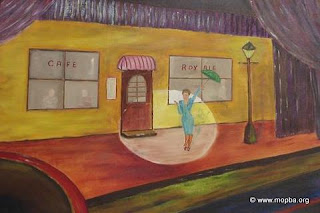Sports is one of the oldest interactive hobbies in the world. It can be played professionally or just as a good past time activity that you love. Nevertheless, it dates back thousands of years ago, from the Romans to the Egyptians and now everywhere. I found a few works from different artists to examine the long history of sports throughout the world. These artist have all done brilliant works, and the ones that i chose can represent the great works they do. Even though these artist uses different modems, you can still see some similarities within them.
The theme of my exhibit would be "History of Sports through MoMA". I chose this theme because sports is one of my favorite hobbies and since MoMA has a lot of interesting works on the different type of sports I figured that I wanted to do that. My art selections related formally by them having the same viewpoint as in the subject "Sports". The similarities that they share in appearance would be the evolution of the sport, from seeing how it used to be to what it is today. While some of the rules might of changed, it still has the similarly equipments use to play the games. Nevertheless, the equipments will be different from those many years ago but with the same conceptual form and shape it will remain the same as in relation to the name of the sport.
These pieces do not evoke any common feelings or meanings for me, it simply makes me respect them more because of where they came from. The other similarities that i can draw from these pieces is that from the colors used by most, viewers can tell how old or how long ago the work was intended to represent. My analysis was not affected by knowing where or when the work was created because for something to last that long it shows how popular it has become. Also the works shows the evolution of the sports.
Gustavs Klutsis
"Postcard for the All Union Spartakiada Sporting Event"
1928
Offset lithograph
Gustavs Klutsis
"Postcard for the All Union Spartakiada Sporting Event"
1928
Offset lithograph
Gustavs Klutsis
"Postcard for the All Union Spartakiada Sporting Event"
1928
Offset lithograph
Gustavs Klutsis
"Postcard for the All Union Spartakiada Sporting Event"
1928
Offset lithograph
Gustavs Klutsis
"Postcard for the All Union Spartakiada Sporting Event"
1928
Offset lithograph
Gustavs Klutsis
"Spartakiada Moskva"
1928
Letter Press
Gustavs Klutsis
"Postcard for the All Union Spartakiada Sporting Event"
1928
Letterpress
Gustavs Klutsis
"Postcard for the All Union Spartakiada Sporting Event"
1928
Offset lithograph

Cindy Van Den Bremen
"Capsters Sports Headgear for Muslim Women. Skate version"
1999
Polyamide and elastane

Cindy Van Den Bremen
"Capsters Sports Headgear for Muslim Women. Tennis version"
1999
Polyester
Richard Avedon
"Lew Alcindor, basketball player, New York"
May, 2nd 1963
Gelatin silver print, printed 1990
Francis Benjamin Johntson
"A football team"
1899-1900
Platinum print
Henry Taylor
"The Long Jump by Carl Lewis"
2010
Acrylic on canvas
Sigmar Polke
"Untitled from the series TV Picture Ice Hockey"
1973
Gelatin silver prints
Slazengers Ltd. England
"Cricket Bat"
Before 1962
Wood with rubber grip
























